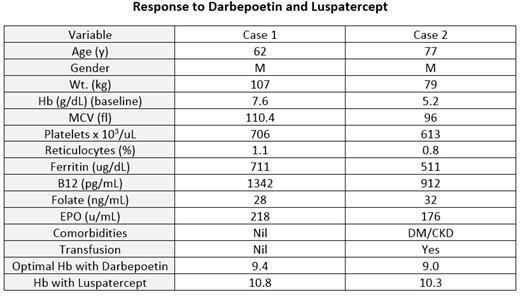Introduction: Low-risk MDS is characterized by refractory anemia due to Dyserythropoiesis 1. Standard of care treatment is mainly Erythropoiesis stimulating agents (ESA) or blood transfusion or both 1. Response to ESA is achieved in some patients whose erythropoietin (EPO) level is less than 500 mu/ml 2. Luspatercept is a red cell maturing agent that may lead to an increase in Hb of up to 3 g/dL 3 in responders. Response to ESA can be enhanced with the addition of Luspatercept 4.
Hereby we are reporting successful shifting of two patients from Darbepoietin to Luspatercept with significant increase in Hb level and improvement in quality of life.
Case 1: A 62-year-old man without previous illness presented in April 2018 with progressive symptomatic anemia. His body weight was 107 kg, and his physical examination was unremarkable other than pallor and tachycardia. The laboratory investigation revealed WBC, 5.62 x 10 3/uL, RBC 2.2 x 10 3/uL, Hb 7.8 g/dL, MCV 110.4 fl, platelets 706 x 10 3/uL, and reticulocytes 1%. Blood film showed reduced RBC count with numerous macrocytes and no other abnormalities. Bone marrow revealed 80% cellularity with Dyserythropoiesis, 16% ring sideroblasts, and 2% blasts. The Ferritin level, B12 levels were elevated (table). EPO level was elevated but less than 500 mlU/ml and the cytogenetic analysis showed normal karyotype. However his molecular profiling demonstrated SF3B1 and TET2 mutations. At the time of diagnosis, the Revised International Prognostic Scoring System (IPSS-R) was 2.0, indicating low risk MDS. He was given darbepoetin 300 mcg SC weekly for four weeks without any improvement, then darbepoetin dose was escalated to 500 mcg weekly with a good response. Hb level remained at 8.5 - 9.5 g/dl for three years.
The patient's physical performance improved moderately, with an increase in walking distance on flat surfaces from 20 to 35 minutes. In August 2022, he was switched to Luspatercept 100 mcg SC on a three-weekly schedule. Within three months, his hemoglobin level increased to 10.8 g/dl and he experienced significant improvement in physical performance and mental well-being, along with a significant reduction in fatigue, enabling him to increase his walking distance to 76 minutes.
Case 2: A 77-year-old man with type 2 diabetes mellitus and mild renal impairment who developed an unexplained progressive anemia. His body weight was 79 kg, and his physical examination was unremarkable other than pallor. His laboratory investigations showed WBC 4.5 x 10 3/uL, RBC 1.5 x 10 6/uL, Hb 5.2 g/dL, MCV 96 fl, platelets 706 x 10 3/uL, and reticulocytes 0.8 %. Blood film showed reduced RBC count, normocytic anemia, and no other abnormalities. Bone marrow revealed 60% cellularity with Dyserythropoiesis, 17% ring sideroblasts, and 1% blasts. His baseline serum creatinine was 1.8 mg/dl, and HbA1C 10.0.
Two units of packed red blood cells were transfused every 2- 4 week to keep his Hb level around 8 g/dL. Darbepoetin 80 mcg SC weekly for four weeks,150 mcg weekly for 4 weeks and 300 mcg weekly for further 4 weeks without any response. Eventually, he responded to 500 mcg of Darbepoetin per week. As a result, his Hb increased to the range of 8.6-9.4 g/dl for one year, with moderate improvements in performance status.
Darbepoetin was switched to Luspatercept 75 mcg three-weekly in January 2023, resulting in an increase in his hemoglobin level to 10.3 g/dl, with significant improvement in his energy level and overall well-being.
Discussion:
Blood transfusion and ESA have traditionally been used as standard treatments for low-risk MDS. Recently, Luspatercept in combination with ESA has shown enhanced effectiveness in elevating Hb levels. Both of our patients had significant increases in Hb levels along with a noticeable improvement in quality of life because of Luspatercept alone.
Conclusion:
Following the switch from Darbepoetin to Luspatercept, there was a significant improvement in Hb level and in quality of life in our 2 patients. This finding needs to be confirmed with larger studies.
References:
1.Nimer SD. Myelodysplastic Syndromes. 2008
2. Meunier M. Lower-Risk myelodysplastic syndrome: Current treatment options for anemia. 2022
3.Zhou L. Inhibition of the TG-beta receptor I kinase promotes hematopoiesis in MDS. 2008
4. Korokji RS. Activity of Luspatercept an ESA combination for treatment of anemia in lower- risk myelodysplastic syndromes
Disclosures
Owaidah:Novonordisk, Pfizer, Novartis, Takeda, Sobi: Consultancy, Honoraria, Membership on an entity's Board of Directors or advisory committees, Speakers Bureau.


This feature is available to Subscribers Only
Sign In or Create an Account Close Modal